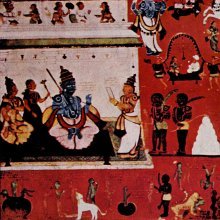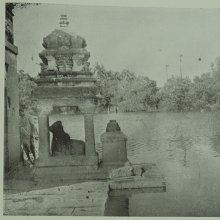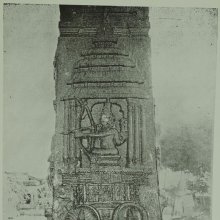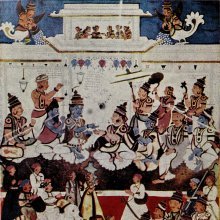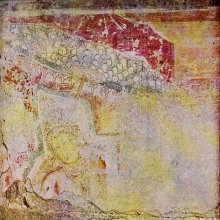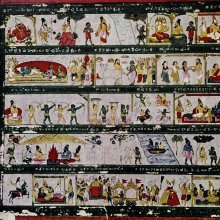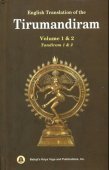Kancipura, Kāñcīpura, Kancipuram, Kāñcipura, Kanchipuram, Kāṃcīpura, Kanci-pura, Kamci-pura: 13 definitions
Introduction:
Kancipura means something in Buddhism, Pali, Hinduism, Sanskrit, the history of ancient India, Tamil. If you want to know the exact meaning, history, etymology or English translation of this term then check out the descriptions on this page. Add your comment or reference to a book if you want to contribute to this summary article.
Alternative spellings of this word include Kanchipura.
Images (photo gallery)
(+528 more images available)
In Hinduism
Vaishnavism (Vaishava dharma)
Source: Acta Orientalia vol. 74 (2013): Historical sequence of the Vaiṣṇava DivyadeśasKāñcīpuram (or Attiyūr, Satyavradakṣetra/Satyavratakṣetra) refers to Kacci-Attikiri, one of the 108 Vaishnava Divya Desam (divyadeśas or divyasthalas), located in the topographical division of Toṇṭaināṭu (“Northern Tamil Nadu”), according to the 9th century Nālāyirativviyappirapantam (shortly Nālāyiram).—Tradition would record the Vaiṣṇava divyadeśas or divyasthalas are 108. The divyadeśa is a base of the cult of Viṣṇu in Viṣṇuism [Vaiṣṇavism] tradition. The list of 108 [viz., Kāñcīpuram] seems to have reached maturation by about the early 9th century CE as all the deśas are extolled in the hymns of the twelve Āḻvārs.
Source: Acta Orientalia vol. 74 (2013): Historical sequence of the Vaiṣṇava DivyadeśasKāñcīpura is short for Kāñcīpuram (or Attiyūr, Satyavradakṣetra/Satyavratakṣetra), which refers to Kacci-Attikiri, one of the 108 Vaishnava Divya Desam (divyadeśas or divyasthalas), located in the topographical division of Toṇṭaināṭu (“Northern Tamil Nadu”), according to the 9th century Nālāyirativviyappirapantam (shortly Nālāyiram).—Tradition would record the Vaiṣṇava divyadeśas or divyasthalas are 108. The divyadeśa is a base of the cult of Viṣṇu in Viṣṇuism [Vaiṣṇavism] tradition. The list of 108 [viz., Kāñcīpura] seems to have reached maturation by about the early 9th century CE as all the deśas are extolled in the hymns of the twelve Āḻvārs.

Vaishnava (वैष्णव, vaiṣṇava) or vaishnavism (vaiṣṇavism) represents a tradition of Hinduism worshipping Vishnu as the supreme Lord. Similar to the Shaktism and Shaivism traditions, Vaishnavism also developed as an individual movement, famous for its exposition of the dashavatara (‘ten avatars of Vishnu’).
Shaktism (Shakta philosophy)
Source: Google Books: ManthanabhairavatantramKāṃcīpura (कांचीपुर) is the name of an upapīṭhas, according to the Śrīmatottara-tantra verse 3.135-138, an expansion of the Kubjikāmatatantra: the earliest popular and most authoritative Tantra of the Kubjikā cult.—The Upapīṭhas are Śrījayantī, Kulutā, along with Mālava and Mahaujas, Kāṃcīpura, Kurukṣetra, Barbara, and Sāṃvara.

Shakta (शाक्त, śākta) or Shaktism (śāktism) represents a tradition of Hinduism where the Goddess (Devi) is revered and worshipped. Shakta literature includes a range of scriptures, including various Agamas and Tantras, although its roots may be traced back to the Vedas.
In Buddhism
Theravada (major branch of Buddhism)
Source: Pali Kanon: Pali Proper NamesA city in Southern India on the Coromandel coast, capital of the Pallavas, and one of the seven sacred towns of India; it is the modern Conjevaram. It was once the centre of Buddhism in South India and was one of the places of pilgrimage visited by Hiouien Thsang. He mentions that during his stay there three hundred monks came to Kancipura from Ceylon, fleeing from the political disturbances in that country (Beal, op. cit., ii.228f; CAGI.627). In Pali Literature the locality is noteworthy as the birthplace of the Commentator Dhammapala and perhaps also of Anuruddha, author of the Abhidhammattha Sangaha (P.L.C.113, 169). Some identify Kancipura with Satiyaputta of Asokas Rock Edict II. E.g., J.R.A.S., 1918, 541f; see also Bhandarkar, Anct. Hist. of Deccan pp.47, 52.
-- or --
See Kancipura.
Theravāda is a major branch of Buddhism having the the Pali canon (tipitaka) as their canonical literature, which includes the vinaya-pitaka (monastic rules), the sutta-pitaka (Buddhist sermons) and the abhidhamma-pitaka (philosophy and psychology).
India history and geography
Source: Institut Français de Pondichéry: The Shaivite legends of KanchipuramKāñcipuram, in Tamil Nadu, is one of the principal permanent seats of Hinduism where Vaiṣṇavism and Śaivism have co-existed since a very long time. The Kāñcipurāṇam, a text in Tamil dating back to the second half of the 18th century, narrates the various legends connected to the site. It is attributed to the poet Civañan̠acuvāmi and was inspired from a Sanskrit Kāñcimāhātmya said to belong to the Skandapurāṇa. Though pan-Indian in its religious traditions, it is deeply rooted in and adapted to Kāñci and has ensured the transmission and popularity of the Śaiva tradition of Kāñci to the present day. It is summarized here in French and illustrated with photographs taken in the temples of Kāñcipuram and other sites of Tamil Nadu.
Source: What is India: Inscriptions of the Early Gupta KingsKāñcīpura (काञ्चीपुर).—Kāñcī is undoubtedly the modern Conjeeveram (Kāñcīpuram, Kāñcīpura) in the Chingleput District, Tamil Nadu.
Source: DSpace at Pondicherry: Siddha Cult in Tamilnadu (historical)Kāñcipuram (12°50’N; 79°42’E) of Tamilnādu was once famous for its Buddhist Siddhāchāryās. It is believed that Ācāryā Nāgārjuna (500 C.E.) was initiated to mystic doctrine by one Vajra-Sattva, a resident of Kāñci. Then one Amogha-Vajra, one of the disciples of Vajra-Bodhi, (Bodhi-Darma) another native of Kāñci was believed to be responsible for the introduction of Tāntric Yoga tradition in China and taught them esoteric philosophy
Source: Shodhganga: The significance of the mūla-beras (history)Kāñcipuram or Kanchipuram, the Golden City, was the capital of the Pallava dynasty from the sixth to the eight century. Kāñcipuram was ruled subsequently by the Chola, Vijayanagara and Nayaka kings until the 17th century. The Kāmākṣī Amman Temple at Kāñcīpuram (the ancient city of temples) is one of the leading centers of Śakti-worship in Tamilnadu. It is situated to the south east of the Ekāmbaranāthar Temple. Kāñcīpuram is divided into two parts–the Big and the Small or the Śivakāñcī and the Viṣṇukāñcī respectively. Śivakāñci is dedicated to Ekāmbaranāthar and Viṣṇu Kāñci to Varadarāja Perumāl.
Source: Shodhganga: Temple management in the Āgamas (history)Kāñcīpura is the name of an ancient city where Shaivism thrived between the 6th century, according to R.G. Bhandarkar (1913).—“Inscriptions in the temples at Kāñcīpura contain evidence of Saivism being in a flourishing condition in the sixth century. The Pallava king Rājasiṃha constructed a temple, and the god inside was named after him Rājasiṃheśvara. Rājasiṃha appears from some of the Inscriptions to have been a contemporary of the early Cālukya prince Pulakesin I., who may be referred to about the year 550 A.D., as his son Kīrtivarman I, came to the throne about the year 567 A.D”.
Source: Shodhganga: Siddha Cult in TamilnaduKanchipuram refers to one of the various famous Siddha Centre distributed throughout South India and Tamil Nadu. The Siddha cult represents a Tantric philosophy that emerged from the combination of several elements found in traditions such as Shaivism (viz., Pashupata), Shaktism, Jainism, Tantric Buddhism (Vajrayana), etc. Both the Siddha and the Navanath cult (i.e., Nava-natha, ‘nine saints’) are popular in South India [viz., Kanchipuram] and Tamilnadu. A Siddha was an inspired seer belonging to the marginalized sections of society who dissolved their past karma and crushed the roots of future karma.

The history of India traces the identification of countries, villages, towns and other regions of India, as well as mythology, zoology, royal dynasties, rulers, tribes, local festivities and traditions and regional languages. Ancient India enjoyed religious freedom and encourages the path of Dharma, a concept common to Buddhism, Hinduism, and Jainism.
Languages of India and abroad
Sanskrit dictionary
Source: Cologne Digital Sanskrit Dictionaries: Monier-Williams Sanskrit-English DictionaryKāñcīpura (काञ्चीपुर):—[=kāñcī-pura] [from kāñcī] n. Name of a town (Kāñcī), [Kāśikā-vṛtti on Pāṇini 6-2, 99]
[Sanskrit to German]
Sanskrit, also spelled संस्कृतम् (saṃskṛtam), is an ancient language of India commonly seen as the grandmother of the Indo-European language family (even English!). Closely allied with Prakrit and Pali, Sanskrit is more exhaustive in both grammar and terms and has the most extensive collection of literature in the world, greatly surpassing its sister-languages Greek and Latin.
Tamil dictionary
Source: DDSA: University of Madras: Tamil LexiconKāñcīpuram (காஞ்சீபுரம்) [kāñcī-puram] noun < Kāñcī +. Conjeevaram, in Chingleput district, an ancient sacred city, one of catta-puri, q. v.; சத்தபுரிகளுள் ஒன்று. [sathapurigalul onru.]
Tamil is an ancient language of India from the Dravidian family spoken by roughly 250 million people mainly in southern India and Sri Lanka.
See also (Relevant definitions)
Partial matches: Pura, Kanci, Puram.
Starts with: Kanchipuranam, Kancipuraka.
Full-text (+883): Kanci, Ulagalantha Perumal, Akacacapai, Kaccipati, Arulalapperumal, Atti-kirimanmiyam, Kamakshi, Vaikuntha Perumali, Kancipuri, Mancanirnati, Kancipuraka, Pirutivilinkam, Karakatu Perumal, Veda-matha, Kantan, Nirakam, Kantirpavai, Arana Valli, Viripara, Urdhvatandavamurti.
Relevant text
Search found 37 books and stories containing Kancipura, Kāñcīpura, Kancipuram, Kāñcipura, Kāñcīpuram, Kāñcipuram, Kāṃcī-pura, Kāñcī-pura, Kanchipuram, Kāṃcīpura, Kanci-pura, Kamci-pura, Kāñchipuram, Kāñchīpuram, Kancheepuram, Kāñcī-puram, Kanci-puram, Kaancheepuram, Kanchpuram, Kanjipuram; (plurals include: Kancipuras, Kāñcīpuras, Kancipurams, Kāñcipuras, Kāñcīpurams, Kāñcipurams, puras, Kanchipurams, Kāṃcīpuras, Kāñchipurams, Kāñchīpurams, Kancheepurams, purams, Kaancheepurams, Kanchpurams, Kanjipurams). You can also click to the full overview containing English textual excerpts. Below are direct links for the most relevant articles:
Temples in and around Madurantakam (by B. Mekala)
Antiquity of Kanchipuram < [Chapter 1 - Historical Backdrop]
Rule of Pandyas < [Chapter 1 - Historical Backdrop]
Parama Samhita (English translation) (by Krishnaswami Aiyangar)
Pāñcarātra worship common in South Indian temples < [Introduction]
Vastu-shastra (5): Temple Architecture (by D. N. Shukla)
Bhaumika Vimānas (Temples of South India, Decan and Greater India) < [Chapter 12 - History of Hindu Temples (Prāsādas and Vimānas)]
Tiruvaymoli (Thiruvaimozhi): English translation (by S. Satyamurthi Ayyangar)
Pasuram 2.10.1 < [Section 10 - Tenth Tiruvaymoli (Kilar oli ilamai)]
Pasuram 1.1.1 < [Section 1 - First Tiruvaymoli (Uyarvu ara Uyar Nalam)]
Pasuram 4.7.5 < [Section 7 - Seventh Tiruvaymoli (Cilam illac ciriyan)]
Pallava period (Social and Cultural History) (by S. Krishnamurthy)
Sources for Study < [Chapter 1 - Introduction]
Earlier Works < [Chapter 1 - Introduction]
Origin of Sculptural Art (b): Pre-Pallava Period < [Chapter 2 - Origin of Sculptural Art—Its Development and Scheme]
Sanskrit sources of Kerala history (by Suma Parappattoli)
The Inscriptions of Sangramadhira < [Chapter 1 - Historical details from Sanskrit Inscriptions]
The Poonamallee inscription < [Chapter 1 - Historical details from Sanskrit Inscriptions]
2. The Hamsa-sandesha by Purnasarasvati < [Chapter 4 - Traces of Historical Facts from Sandesha Kavyas and Short poems]
Related products
